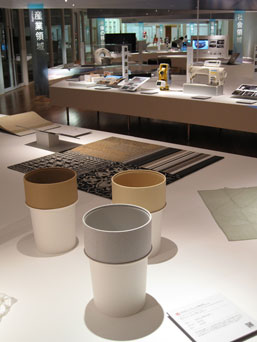Products for a Perfect World
The most idealistic projects on view at the Good Design Awards exhibition are also the least attractive. The atmosphere of the competition is unabashedly optimistic, particularly in the “Mobility” category. There, designers attempt to imagine a cleaner, greener, and more convenient future, with ingenious but not always beautiful results. The Dual Mode Vehicle (DMV) from the Hokkaido Railway Company is big, yellow, and clunky, for example, but its looks are more than offset by its functionality: it can operate on both roads and railway tracks, switching between the two modes in only fifteen seconds.

Also promising is the Wireless Earthquake Detector and Outlet Control System from Tokyo Denki, a gadget that automatically disconnects hazards like irons in the event of an earthquake. Given the massive fire damage caused by hot lunchtime ovens at the time of the 1923 quake, this could be a lifesaving innovation.
Prettier but much less important are the paper “trash pots” proposed by Drill Design in three neutral colors: there’s just something daring about a waste receptacle that’s made of the same material as the waste itself. But the company claims this trashcan is hardy and long lasting, and when its life cycle eventually ends it can be responsibly recycled.
And in the “gotta have it” category: CD protectors in candy colors from Kanou Seiko Corp. and even brighter-colored USB memory sticks from Rightning Inc., whose soft rubber tails can tie onto a belt loop or backpack strap for easy transport.
Takenaka’s Gyre building, designed by the Dutch firm MVRDV, makes it into the room, represented by a swanky lit-Plexiglas model. Mori Shoji Company offers a ruffly towel that would be a hit in Harajuku. Shin + Tomoko Azumi are showing a modular seating system whose laminate seat is bent three-dimensionally into sinuous curves: lovely as a bench, but unfortunately lumpy and awkward when stacked. Keep working on that one, guys, and better luck next year.
Jessica Niles DeHoff
Jessica Niles DeHoff



